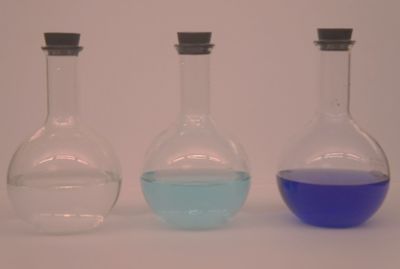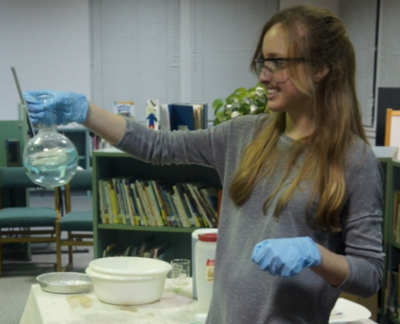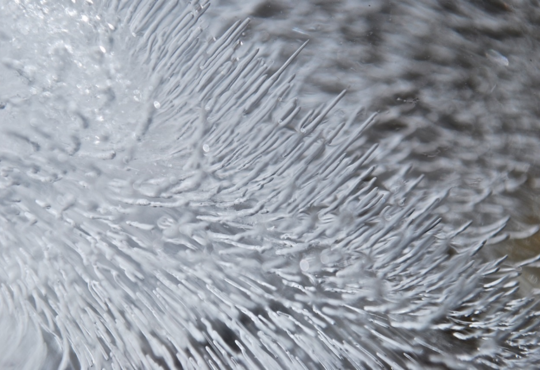Every year during basketball season, two institutions, the University of North Carolina (UNC) and Duke University, battle on the court to see which team (and university) can claim the title of being the best. As they are only eight miles apart and have two of the best coaches in all of college basketball, one can only imagine the intensity of the rivalry between the two schools. NC students participate in a lottery for tickets to the game while Duke students camp out for weeks on end, in the cold of winter just to get tickets for their home game. At UNC’s home game, the students, all dressed in sky blue, are boisterous, jumping up and down throughout the game. At Duke’s home game, the students are doing the same but all dressed in dark blue. After the game has concluded, if the home team has won, bonfires are set ablaze as the students celebrate the victory.
It just so happens that the Duke students in the second half of general chemistry study complex ions around the same time as this seasonal highlight. Why not use a demonstration to show the nature of metallic complexes while the students are so focused on the upcoming games?
The demonstration is easy to perform. A small amount of solid copper(II) chloride is added to a flask half-filled with deionized (DI) water and mixed. A sky blue color (UNC blue) results ─ hexaaquacopper(II) ion, [Cu(H2O)6]2+. A small amount of 5 M ammonia solution is then added to the mixture forming an intense dark blue solution (Duke blue) ─ tetraamminecopper(II) ion, [Cu(NH3)4(H2O)2]2+. You will notice that four of the water molecules are replaced by the ammonia molecules.
CuCl2(s) + 6 H2O(l) g [Cu(H2O)6]2+(aq) + 2 Cl1-(aq)
Cu(H2O)62+(aq) + 4 NH3(aq) ⇌ [Cu(NH3)4(H2O)2]2+(aq) + 4 H2O(l)
Cu2+ is the central metallic ion while H2O and NH3 both act as ligands, each having a lone pair of electrons to donate to the copper(II) ion. The Cu2+ ion acts as a Lewis acid (electron pair acceptor) while the ligands act as Lewis bases (electron pair donors). For example:
Cu2+ + ꞉NH3 → [Cu – NH3]2+
Crystal Field Theory has been used to explain the interactions between ligands and the central metallic ion and the resulting colors of the solutions formed. The theory goes beyond the scope of this article. Those interested can find the theory in most general chemistry or inorganic chemistry texts, and online.
Because of the notoriety of the Battle of the Blues in our area, we have found this demonstration to be quite popular at chemistry outreach events, as well as in our general chemistry classes. Even the youngsters, who might not understand much of the underlying concepts, cheer or boo depending on which blue appears and which team they are rooting for.
Whether or not you have a Battle of the Blues in your area, this demonstration is a great way to introduce and discuss the concepts relevant to complex ions.
Battle of the blues
Concepts
- Complex ions
- Ligands
- Lewis acids and bases
- Crystal field theory
Materials
- One 1-L Florence flask — or smaller — fitted with rubber stopper or cork
- ~500 mL DI water — or 1/2 volume of flask used
- ~1.0 g of solid copper(II) chloride — or less, depending on the volume of water used
- ~15 mL of 5 M ammonia solution — or less, depending on the volume of solution
Safety
- Wear protective goggles/safety glasses and gloves
- Copper(II) chloride is corrosive, causes skin, eye and respiratory tract burns. Harmful if inhaled or swallowed. Solution is mildly toxic.
- Ammonia solution is mildly toxic by ingestion and inhalation.
Advance preparation
- The ammonia solution should be prepared in advance in a fume hood. Using concentrated ammonia (15 M) dilute 1 part ammonia with 2 parts water (by volume). Measure out the needed quantity to be used in the demonstration in the fume hood; place in a sealed container.
- If desired, half fill the flask with DI water in advance.
Procedure
- Add the solid copper(II) chloride to the water in the flask. Stopper and swirl to mix. Note the color.
- Add the 5 M ammonia solution. Stopper and swirl to mix. Note the color.
Observations
- Before adding to the water, the copper(II) chloride is green.
- After adding to the water, the hexaaquacopper(II) ions formed have a sky blue color (UNC blue).
- After adding the ammonia to the mixture, the [Cu(NH3)4(H2O)2]2+ ions formed have a dark blue color (Duke blue).
- Note: addition of 6 M nitric acid will convert the [Cu(NH3)4(H2O)2]2+ back into the hexaaquacopper(II) ions (of course we do not tell anyone about that).
Clean up
The resulting solution CANNOT be disposed of in the sink.* The copper(II) ions will interact with the bacteria necessary for cleaning the water. Check with your local authorities as to how best to treat/dispose of the resulting solution BEFORE conducting this demonstration.


*One of the Chem 13 News proofreaders suggested that one could evaporate off the water and the ammonia leaving the solid CuCl2 for next year.
Dr. Kenneth Lyle is a lecturing-fellow in the Department of Chemistry at Duke University, NC. The Powell Family Trust, the Duke-Durham Neighborhood Partnership, and Biogen Idec – Research Triangle Park fund the Duke Chemistry Outreach Program.






